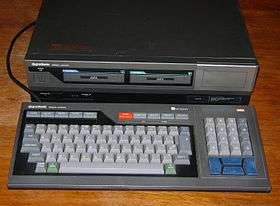Gradiente Expert
 | |
| Type | home computer |
|---|---|
| Release date | December, 1985 |
| Discontinued | 1991 |
| Operating system | MSX BASIC, MSX-DOS, CP/M |
| CPU | Zilog Z80A/MSX Engine T7937A @ 3.58 MHz |
| Memory | 64 KB–256 KB (max.) |
The Expert, made by Gradiente Eletrônica (to date best known as a game console and Hi-Fi equipment company) was the second and last MSX home computer launched in the Brazilian market, in the mid-1980s.
It was presented to the public at the 5th International Computing Fair, nicknamed "Informatica '85". The event took place at Anhembi Exhibition Center in the city of São Paulo from September 23 to 29, 1985.[1] At the announcement, the computer was priced 65 ORTN s.[2]
Its market release date was 1 December 1985, one week after Epcom's Hotbit, just in time for 1985's Christmas and with a massive media campaign on magazines, newspapers and TV. In the newspapers ads the initial offer price was Cr$4.640.000,00 Brazilian Cruzeiros (BRB), or US$493,62 (USD) by the value at the time.[3]
The machine was a clone of the National CF-3000, with a computer case resembling a stereo system, a detached keyboard with a proprietary connector, no caps lock LED and no reset key,[4] although the soft-reset could be achieved by pushing in either of the cartridge slot covers.
The Expert XP-800 was followed by the Expert GPC-1 ("Gradiente Personal Computer") in 1987, and by Expert Plus and Expert DD Plus (a system with a built-in 720 KB 3½" disk drive) in 1989. The Expert users waited in vain for an MSX2 machine, but Gradiente never produced it[4] and discontinued the MSX line in 1991.[5]
Versions XP-800/GPC-1
The two first versions had a graphite case and socketed chips, which caused a chronic problem: when the machine heated, the chips frequently pulled out and the system "froze". Also, the GPC-1, released in 1987, had a ROM slightly modified to solve an ASCII table compatibility issue with the other popular Brazilian MSX, Sharp's Hotbit.[5]
Versions Plus/DD Plus
The last two versions had a black case and the problematic socketed chips were replaced by an ASIC. Nevertheless, the RAM was mapped to a secondary slot and, although it was straight by the MSX standards, caused a lot of crashes with programs who searched for memory in the wrong place. It did not contribute for the popularity of any of the Plus versions.[4]
Technical specifications
| CPU | Zilog Z80A (XP-800 & GPC-1) @ 3.58 MHz MSX Engine T7937A (Plus & DD Plus) @ 3.58 MHz |
| RAM | 64 KB |
| VRAM | 16 KB (Texas Instruments TMS9918) |
| ROM | 32 KB |
| Keyboard | mechanic, 89 keys (with 4 cursor keys), number pad |
| Display | text: 40×24 rows; graphics: 256×192 pixels, 16 colours, 32 sprites |
| Sound | General Instrument AY-3-8910 (PSG), 3 voices, white noise |
| Ports | 2 joystick connectors, TV out, RGB monitor out, sound out, tape recorder connector, parallel port, 2 cartridge slots |
| Storage | tape recorder (1200/2400 bit/s) or one or two external disk drive (5¼", 360 KB or 3½", 720 KB) |
Peripherals
- DR-1 ("data-corder"): tape recorder
- JS-1: joystick
- MBW-12: 12" green CRT monochrome monitor
- TA-1: TV adapter
- TM-1: 1200/75 bit/s modem with a RS-232C port
Notes
- ↑ (Portuguese)-"Uma Vitrine Renovada" VEJA Magazine Nº891, p.88,89 São Paulo, 02/Oct/1985
- ↑ (Portuguese)-"A Microinformática no Brasil" Micro Sistemas Magazine, Special Edition Informatica '85, p.36, Rio de Janeiro, Sep/1985
- ↑ (Portuguese)-"BRENO ROSSI shop advertising" Newspaper O Estado de S. Paulo Nº33.987, p.24, São Paulo, 15/Dec/1985
- 1 2 3 Gradiente Expert Plus at old-computers.com
- 1 2 (Portuguese)-The MSX in Brazil
External links
- Expert XP-800 @ MSX.org website
- (Portuguese)-Gradiente Expert
- (Portuguese)-Gradiente Expert Plus/DD Plus